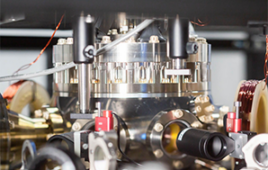By taking advantage of nature’s own inherent symmetry, researchers at Chalmers University of Technology in Sweden have found a way to control and communicate with the dark state of atoms. This finding opens another door towards building quantum computing networks and quantum sensors to detect the elusive dark matter in the universe.
“Nature likes symmetries and so do we. The foundation of our experiments is an innovative engineering trick where we control and make use of the available symmetries in a system which otherwise is very challenging to tame”, says Dr. Aamir Ali, a researcher in quantum technology and primary author of the study.

Aamir Ali, Post-doctoral researcher at the Department of Microtechnology and Nanoscience, Division of Quantum Technology, Chalmers University of Technology
Quantum computers have the potential to vastly surpass today’s most advanced computers. A quantum computer is based on so-called quantum bits, or qubits, which can be in a superposition of its possible states, 0 and 1, simultaneously. This phenomenon allows quantum computers to handle vast amounts of data. The superpositions are extremely fragile, so they need to be protected from external disruptions to prevent them from collapsing.
Building a large-scale quantum computer, therefore, presents a major challenge, with an increasing number of qubits, the collective system becomes increasingly more fragile. For this reason, a key research field is the development of large quantum networks where computing tasks are processed and distributed across different nodes of the network. One attractive way to realize such networks is to use artificial atoms* as qubits. Atoms interact naturally with light, by absorbing or emitting photons. However, ensembles of two or more atoms can exist in superposition states, named dark states, in which they are completely transparent to light, meaning that they neither emit nor absorb it. These dark states have great potential in quantum technology because they are immune to external influences and disruptions. For the same reason, controlling the dark states and using them to exchange information is a difficult task.
Tuning in to the tiny symmetries of atoms
Now, researchers at Chalmers University of Technology have developed a simple, high-precision method to control the dark states of a molecule consisting of two interconnected artificial atoms. The study has been published in Physical Review Letters.
From butterfly wings and snowflakes to the tiniest components of our physical world, nature strives for symmetry to create balance and harmony. This is also true of the energy levels in an atom. The qubits that Aamir Ali and his colleagues used consist of two coupled artificial atoms made up of superconducting** circuits. When light particles – photons – are sent into the atoms through a waveguide***, they can interact with the energy levels of two different available symmetries. In previous research, only one waveguide has been coupled to the qubit with limited access to its symmetries, but the Chalmers researchers instead used two waveguides, each coupled separately to one of the symmetric states. Because of the symmetric energy distribution in the artificial atoms, one of the waveguides will be coupled to a dark state and the other to its complementary bright state. This makes them receptive to being manipulated and controlled independently of each other.
New applications in quantum technologies
This ability to control the dark states presents a new approach to applications in quantum technologies. Using Chalmers researchers’ engineering, it is possible to create a quantum entanglement*** between the dark and bright states, unlocking new ways to process quantum information and transmit it in a quantum network. Furthermore, it also allows for the development of sensors that can absorb low-energy microwave photons. A photon detector in this domain could contribute to the detection of dark matter in the Universe. The researchers are also going to use these new results in thermodynamics to see if the laws of quantum mechanics can be used to achieve advantages in engines or batteries.

Simone Gasparinetti, assistant professor at the Department of Microtechnology and Nanoscience, Division of Quantum Technology, Chalmers University of Technology. Principal Investigator of the Wallenberg Centre for Quantum Technology
“We can engineer synthetic molecules with unique symmetries, which leads to novel ways for these molecules to interact with microwave light. The concept we demonstrated is elegant and powerful at the same time, with applications ranging from distributed quantum computing to microwave photodetection”, said Simone Gasparinetti, head of research in experimental quantum physics at Chalmers University of Technology and one of the senior authors of the study.
The research was conducted at Chalmers within the framework of the Wallenberg Centre for Quantum Technology (WACQT), a comprehensive research program, the aim of which is to make Swedish research and industry leaders in quantum technology.
“One of the main goals of WACQT is to build a quantum computer. But there is more to it than that. We have created an environment that encourages researchers to explore less-taken paths while benefitting from infrastructure and expertise in quantum technologies. This work is one such example,” said Simone Gasparinetti.
How it works:
The artificial atoms consist of electronic circuits that, just like real atoms, can only occupy a set of certain – discrete – energy levels. When they are coupled to the two waveguides, they create a shared structure that uses quantum interference to connect the waveguides to two different symmetries that the atoms’ energy levels can assume. Thanks to this coupling to the symmetries, it is easy to simply select and design the energy transitions. This can be done much more easily and effectively than has been demonstrated before, without needing to employ sophisticated phase and pulse control, which is typical in the standard architecture.
Read the full article: Engineering Symmetry-Selective Couplings of a Superconducting Artificial Molecule to Microwave Waveguides
*Artificial atom: A tiny bit of conductive material that holds charge and energy levels in the same way as real atoms. And just like real atoms, it changes its state by emitting or absorbing light at a particular frequency. The artificial atoms used by Chalmers’ researchers are made from superconducting circuits and exchange light at microwave frequencies.
**Superconductivity is the property of certain materials to conduct direct current electricity without energy loss when they are cooled below a critical temperature.
***Waveguide: Structure that routes the photons in microwave signals
****Quantum entanglement: Phenomenon that was awarded the Nobel Prize in physics in 2022. When particles are entangled, a change in one of the particles will cause the traits of the other particles to change as well, no matter the distance between them.
The authors of the study are Mohammed Ali Aamir, Claudia Castillo Moreno, Simon Sundelin, Janka Biznárová, Marco Scigliuzzo, Kowshik Erappaji Patel, Amr Osman, D. P. Lozano, Ingrid Strandberg, and Simone Gasparinetti. The researchers are active at Chalmers University of Technology.
The research was funded by the Swedish Research Council and the Knut and Alice Wallenberg Foundation through the Wallenberg Center for Quantum Technology (WACQT).





Tell Us What You Think!